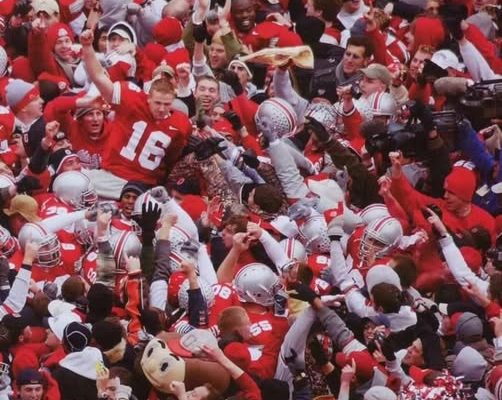The 2002 Ohio State Buckeyes football season remains one of the most unforgettable campaigns in college football history. Under the leadership of head coach Jim Tressel, the Buckeyes defied expectations, navigated countless close calls, and ultimately captured the program’s first national championship in over three decades. Their perfect 14-0 season was a testament to resilience, clutch performances, and a defense that refused to break when it mattered most. From the opening kickoff to the final seconds of the Fiesta Bowl, Ohio State’s journey was a masterclass in perseverance and teamwork.
When Jim Tressel took over the Ohio State program in 2001, he inherited a talented but underachieving squad. In his introductory speech, he famously told fans they would be proud of the team’s performance against Michigan, a bold statement that immediately set expectations high. While his first season ended with a modest 7-5 record, the foundation was being laid for something special. The 2002 season would prove to be the culmination of Tressel’s vision—a team built on discipline, defense, and an unshakable belief in one another.
The Buckeyes entered the season unranked in the AP Poll, a reflection of the skepticism surrounding their potential. However, they quickly silenced doubters with a dominant 45-21 victory over Texas Tech in the opener. Quarterback Craig Krenzel, often overshadowed by flashier counterparts across the nation, emerged as the steady leader the offense needed. While not a prolific passer, Krenzel’s poise in critical moments became a defining trait of the season. Meanwhile, freshman sensation Maurice Clarett burst onto the scene as the workhorse running back, providing the Buckeyes with a dynamic offensive weapon.
As the season progressed, Ohio State found themselves in one heart-stopping battle after another. Their ability to win close games became legendary. In Week 3, they escaped Cincinnati with a 23-19 victory after a late defensive stand. The following week, they edged out a tough Northwestern team, 27-16, but the real tests were still to come. The defining stretch of the regular season arrived in late October and November, when the Buckeyes faced a gauntlet of ranked opponents.
The first major showdown came against Penn State in a raucous Beaver Stadium. In a defensive slugfest, Ohio State trailed 7-6 late in the fourth quarter before Krenzel engineered a game-winning drive, capped by a 5-yard touchdown pass to Michael Jenkins with 1:35 remaining. The 13-7 victory kept their perfect season alive, but even greater challenges loomed. The following week, the Buckeyes needed overtime to outlast Illinois, 23-16, with Clarett scoring the decisive touchdown. Then came the most dramatic game of the season—a showdown with Purdue in which Ohio State trailed late before Krenzel led a last-minute drive, setting up Mike Nugent’s clutch field goal for a 10-6 win.
The regular season finale against Michigan was a classic, as expected. With a trip to the BCS National Championship Game on the line, the Buckeyes and Wolverines traded blows in a physical, emotional battle. Ohio State’s defense, anchored by stars like Mike Doss, Will Smith, and Chris Gamble, rose to the occasion, limiting Michigan’s high-powered offense. Krenzel’s 4th-down touchdown run and a late interception by Will Allen sealed a 14-9 victory, sending Ohio State to the Fiesta Bowl with an unblemished 13-0 record.
The stage was set for a titanic clash with the Miami Hurricanes, the defending national champions and a team many considered unbeatable. Miami boasted a 34-game winning streak and a roster loaded with future NFL stars, including Ken Dorsey, Willis McGahee, Andre Johnson, and Sean Taylor. The Hurricanes were heavy favorites, but Ohio State embraced the underdog role.
The Fiesta Bowl lived up to its billing as an instant classic. Miami struck first, but the Buckeyes responded with a gritty defensive effort and timely plays from Krenzel and Clarett. The game swung back and forth, with Ohio State’s defense forcing key turnovers, including a critical interception by Gamble. The most controversial moment came in overtime when Miami appeared to have secured a game-ending interception, but a late pass interference flag extended Ohio State’s drive. Given new life, Krenzel found Jenkins for a touchdown, and Clarett punched in the two-point conversion. Miami answered with a touchdown of their own, but Ohio State’s defense held firm on the ensuing two-point attempt, securing a 31-24 victory in double overtime.
The win cemented Ohio State’s place in history. Tressel’s team had completed a perfect 14-0 season, overcoming every obstacle in their path. The defense, which allowed just 13.1 points per game, was the backbone of the team, while Krenzel’s leadership and Clarett’s explosive plays provided just enough offense. The victory also marked a turning point for the program, reestablishing Ohio State as a national powerhouse.
Looking back, the 2002 Buckeyes were a team of destiny. They won seven games by a touchdown or less, proving their ability to thrive under pressure. While Clarett’s later troubles overshadowed his contributions, his impact on that season cannot be overstated. Meanwhile, Tressel’s calm demeanor and strategic brilliance were instrumental in guiding the team through adversity.
Twenty years later, the 2002 Ohio State Buckeyes remain a source of pride for fans and a benchmark for resilience in college football. Their journey was anything but easy, but that only made their triumph sweeter. From unranked to undefeated, they proved that heart, determination, and teamwork could overcome even the most daunting odds. The 2002 season wasn’t just a championship run—it was a storybook ending that will forever be etched in the annals of Ohio State football lore.



